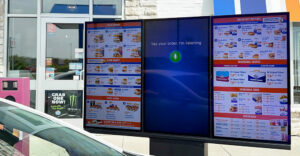Amazon is adding age verification to its palm-based Amazon One identity offering.
The company on Monday announced that the age-verification feature is being rolled out at Coors Field, home of the Colorado Rockies Major League Baseball club.
At the ballpark, customers ages 21 and over can purchase alcoholic beverages by simply hovering their palm over an Amazon One device — as long as they’ve previously enrolled in the Amazon One program.
Consumers already enrolled in the program can add the age-verification feature to their account by going to the one.amazon.com website, uploading a photo of the front and back of a government-issued ID — such as a driver’s license — and a selfie.
Enrollment can also be performed online and at kiosks wherever Amazon One is available, including at the ballpark.
Once enrolled, a consumer can simply hover their palm over an Amazon One device, where a server can see a 21+ message and the consumer’s selfie for verification. A purchase can be paid for with another palm hover and a linked credit card account.
Friction-Free Experience
Verifying a customer’s age for every alcohol purchase is a known friction point for retailers, bars, and breweries, AWS Applications Vice President Dilip Kumar explained on Amazon’s news website.
It leads to longer transaction times and puts a strain on employee productivity, he continued. Amazon One’s age verification capability addresses these challenges and alleviates the burden — and time — of manual ID verification.
“At Coors Field, we have always prided ourselves in putting customer experience first,” John McKay, senior director of food service operations and development for the Rockies, said in a statement.
“As the first sports stadium to enable cutting-edge palm recognition technology like Amazon One for age verification,” he added, “we are enabling a friction-free experience for Colorado Rockies fans so they can grab a drink and get back to the game faster.”
Amazon One’s introduction to biometric age verification signifies a large step toward the future of a single digital identity, maintained Eduardo Azanza, CEO of Veridas, a global biometric identification and authentication solution provider.
“With a highly accurate and reliable method for confirming ages, businesses can stay compliant with age-related laws and reduce the risk of unauthorized access, all while offering a more enjoyable customer experience with reduced lines and faster services,” he told the E-Commerce Times.
“Coors Field is the first of many venues and organizations that will roll out this kind of biometric system,” he continued. “Convenience is essential to good user experience, and businesses are always looking for the most cost-effective and streamlined approach.”
“This development is likely to shape verification practices across various industries, promoting the adoption of biometric technology while also emphasizing the need for strong data privacy and security standards,” he added. “Simple and convenient is the future, and to stay competitive, businesses need to get on board.”
A Wave of Regulation in the Wings
Although age verification is useful in physical venues that sell alcohol, its use beyond that may be restricted. “Biometrics are still not broadly adopted, so use cases will be limited,” Forrester Research analyst Sucharita Kodali told the E-Commerce Times.
“While this technology is interesting in the physical world, what we’re seeing more and more is a need for this type of technology in online verification,” Azanza noted.
“The online industry needs this type of system to make age identification seamless and secure,” he added.
That will be especially true as age enforcement requirements by online websites get tougher.
According to Bloomberg Law, dozens of proposals are pending in states across the country seeking to regulate a child’s experience online. Many would rely on companies like Meta, Alphabet, and TikTok to know the age of their online users.
Online services that fail to meet the requirements of the new laws could face fines anywhere from US$2,500 to $250,000.
Often, activities that require proof of age with a valid form of identification in the physical world can require a mere click in a checkbox online. “There’s a big gap between the digital and physical requirements,” Azanza said.
Privacy Challenges
The problem with getting stricter with the age-determination policies of online services is that gathering more accurate information can also result in scooping up more sensitive data about the person’s identity.
“Do you really want a commercial entity like Amazon to have a scan of your driver’s license, especially one that could go to town combining that information with the rest of their astonishing database on each one of us?” asked Micah Solomon, a customer experience and service consultant based in Seattle.
Amazon claims that it won’t be storing the photos of the government IDs uploaded to Amazon One by consumers after they’re vetted by an ISO 27001-certified identity verification provider.
“Customer comfort should rest with how much they do or don’t trust Amazon’s claim that they don’t store these IDs,” Solomon told the E-Commerce Times. “However,” he added, “customers seem astonishingly okay with letting their IDs get photocopied in clearly unsecured environments like the front desk of their local doctor’s office, so maybe I’m part of a tiny minority who even thinks about such things.”
Craving Warm Experience
Solomon noted that Amazon One might be an ultimate friction reducer in a physical environment, though reducing friction is just part of the picture.
“I emphatically advise my customer experience consulting clients that reducing friction isn’t the end game here. A great customer experience is,” he said.
“In a context where all that customers want out of a provider is for them to get out of the way — which is certainly the case when it comes to age verification — reducing friction is a great thing to focus on,” he explained.
“But in other contexts, where you want a warmer experience — the front lobby of a great, or even decent, hotel, or, ideally, an auto dealer — it’s never going to be the complete experience that customers crave,” he added.
If a business reduces friction at the money-changing point of a commercial transaction, he continued, a forward-thinking business can introduce the warmth customers crave in other areas.
“If you visit any Amazon Fresh store, you’ll emphatically see that this is not happening,” he said. “The only employees even remotely trained and managed to interact with customers warmly — and not nearly run them over with their restocking carts — are the fabulous people at the cash registers.”
“With the cash registers being only rarely used due to the Amazon One technology, the warmth is pretty much sucked out of the experience,” he declared.
Amazon One is available at more than 100 Whole Foods Market stores, select Amazon Go and Amazon Fresh stores, and multiple third-party locations, including Panera Bread restaurants, sports stadiums, entertainment venues, convenience stores, and travel retailers at several U.S. airports.
Amazon said that the age verification capability at Coors Field will be rolled out to additional establishments in the coming months.

























































